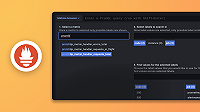Important: This documentation is about an older version. It's relevant only to the release noted, many of the features and functions have been updated or replaced. Please view the current version.
Deploy Grafana Mimir with Jsonnet and Tanka
You can use Tanka and jsonnet-bundler to generate Kubernetes YAML manifests from the jsonnet files.
Install
tankaandjb:Follow the steps at https://tanka.dev/install. If you have
goinstalled locally you can also use:# make sure to be outside of GOPATH or a go.mod project go install github.com/grafana/tanka/cmd/tk@latest go install github.com/jsonnet-bundler/jsonnet-bundler/cmd/jb@latestSet up a Jsonnet project, based on the example that follows:
- Initialize Tanka
- Install Grafana Mimir and Kubernetes Jsonnet libraries
- Set up an environment
#!/usr/bin/env bash # SPDX-License-Identifier: AGPL-3.0-only set -e # Initialise the Tanka. mkdir jsonnet-example && cd jsonnet-example tk init --k8s=1.29 # Install Mimir jsonnet. jb install github.com/grafana/mimir/operations/mimir@main # Use the provided example. cp vendor/mimir/mimir-manifests.jsonnet.example environments/default/main.jsonnet # Generate the YAML manifests. export PAGER=cat tk show environments/defaultGenerate the Kubernetes YAML manifests and store them in the
./manifestsdirectory:# Generate the YAML manifests: export PAGER=cat tk show environments/default tk export manifests environments/defaultConfigure the environment specification file at
environments/default/spec.json.To learn about how to use Tanka and to configure the
spec.jsonfile, see Using Jsonnet: Creating a new project.Deploy the manifests to a Kubernetes cluster, in one of two ways:
Use the
tk applycommand.Tanka supports commands to show the
diffandapplychanges to a Kubernetes cluster:# Show the difference between your Jsonnet definition and your Kubernetes cluster: tk diff environments/default # Apply changes to your Kubernetes cluster: tk apply environments/defaultUse the
kubectl applycommand.You generated the Kubernetes manifests and stored them in the
./manifestsdirectory in the previous step.You can run the following command to directly apply these manifests to your Kubernetes cluster:
# Review the changes that will apply to your Kubernetes cluster: kubectl apply --dry-run=client -k manifests/ # Apply the changes to your Kubernetes cluster: kubectl apply -k manifests/
Note: The generated Kubernetes manifests create resources in the
defaultnamespace. To use a different namespace, change thenamespaceconfiguration option in theenvironments/default/main.jsonnetfile, and re-generate the Kubernetes manifests.Note: A Jsonnet-based installation uses etcd for the HA tracker by default. The Jsonnet-based installation creates the etcd using the etcd-operator. Before applying the
tk applyorkubectl applycommand , make sure that you have the etcd-operator running in your Kubernetes cluster.


